 The issue of how to make the ‘right’ investment decisions is something that many trustees regularly have to deal with. In a recent article in the Third Sector magazine, I debated this issue with a sector colleague, Fred Worth, co-opted Trustee of Mencap, and have included some of the ideas discussed below.
The issue of how to make the ‘right’ investment decisions is something that many trustees regularly have to deal with. In a recent article in the Third Sector magazine, I debated this issue with a sector colleague, Fred Worth, co-opted Trustee of Mencap, and have included some of the ideas discussed below.
For me, a charity’s investment decisions should be guided by two fundamental principles: first that the trustees have a legal responsibility to safeguard the assets of the charity, including cash and investments. By extension, they are required to ensure that they achieve the maximum return for the lowest risk possible. In practice, this can be a difficult balance to strike. On the one hand, charities’ resources are squeezed and any additional income (especially unrestricted) can go a long way. But the level of financial risk that comes with a high return may simply be unacceptable.
Second, any investment decisions made should promote the charity’s objectives, and not have a negative impact on the charity’s objectives. The reputational damage arising from investment decisions that don’t fit in with the charitable aims of the organisation are immeasurable. The recent media frenzy about Comic Relief’s investments (following the BBC’s Panorama programme, All In a Good Cause), is testimony how damaging some investment choices that the trustees make be on the charity and on the sector.
In practice, there’re some steps that trustees can take to help them manage the charity’s investments responsibly.
Here’re my top 10:
- Trustees should work with senior staff to define what they consider to be acceptable forms of investments for their charity. With so much choice in the market, this may be difficult and a lot of research will need to be done;
- List down all the industries or products that they must not invest in as a matter of principle;
- Consider the level of risk that they are prepared to take. All investments carry a risk that the initial investment could be lost, which would have a direct negative impact on the beneficiaries. On the other hand, a higher risk investment may have the highest return which would boost the charity’s ability to reach more beneficiaries;
- For most charities, it would be too expensive to hire an investment specialist and manage the investments in-house. Trustees should consider focussing on managed portfolios, have an analysis the funds in each portfolio, including where the funds are invested;
- Consult with other professionals in their sector – this may be a paid consultant, but in most cases, other professionals from similar charities would be happy to share their experiences for free;
- Have a list of the pros and cos for each fund portfolio, taking account of factors like management fees, rate of return, payment schedules, accessibility i.e. can they withdraw it at will, etc.;
- Try and diversify the investments in order to spread the risk (although this may be unrealistic for most smaller charities);
- Obtain and review investment performance reports as part of the management accounts review;
- Be transparent about the decisions made e.g. by including additional information in public records such as statutory accounts about the investment decisions; and
- Put the charity’s approach to investments in an Investment Policy.

